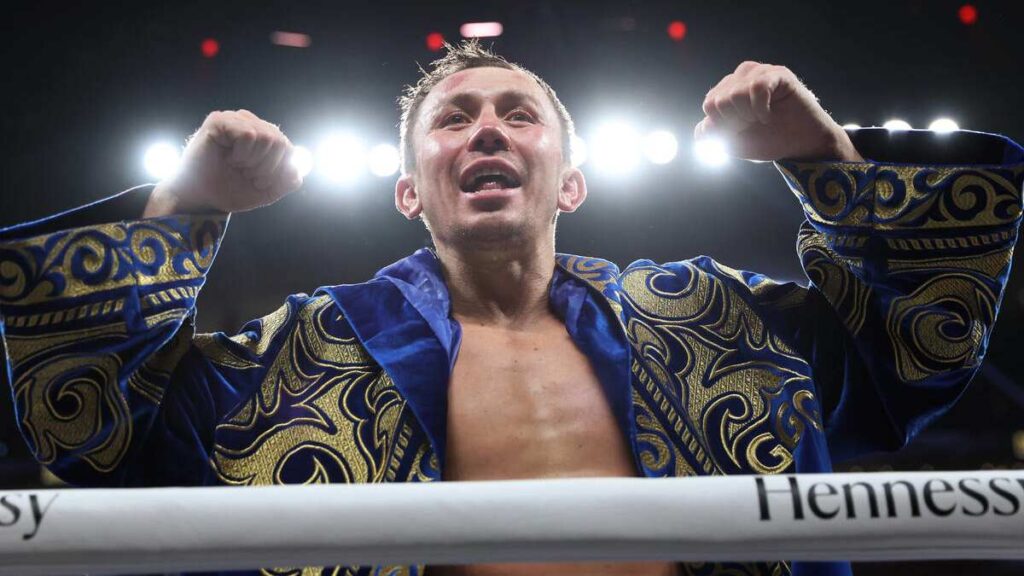In his prime, Gennadiy Golovkin broke opponents in crushing victories like a smiley-faced assassin.
But as ballots for the 2026 Hall of Fame class landed on the desks of Uncrowned and other voters, that image of the quiet Kazakh wrecking machine created a divide between the sport’s media and its fans. Is “Triple G” really this year’s standout entrant?
Advertisement
Golovkin cut off the ring better than almost anyone of his era. He had subtle rather than flashy footwork. And he seemed to have concussive power in his jab alone. That jab is something he used to break opponents down before unleashing hooks and uppercuts. He didn’t necessarily have one-punch knockout power, but it was the accumulation of his thudding shots that made people feel like they’d been hit with baseball bats when they got back to their locker rooms.
There is little doubt that Golovkin had Hall of Fame abilities, but his résumé is thin, which is the source of why some doubt his first-ballot case to Canastota.
His best wins came against Daniel Jacobs, David Lemieux and Kell Brook, and he lost his defining trilogy to Saul “Canelo” Alvarez. His career lacks the signature victories other Hall of Fame middleweights built their legends on — Sugar Ray Robinson had multiple wins over Jake LaMotta. Marvin Hagler bested Roberto Durán and Thomas Hearns, and Bernard Hopkins dismantled Félix Trinidad and Oscar De La Hoya.
Golovkin’s greatness isn’t measured by just names, though.
Advertisement
When HBO Boxing needed a new headliner, he became the face of its final golden run. His English was broken, but his message was ever-quotable as he’d produce a “big drama show” regardless of opponent. He sold out arenas from Los Angeles to New York, and became a cult hero among U.S. and international fans alike.
For this writer, at least, legacy isn’t just about who you fought or when you fought them. It’s also about the impact you had on the sport and the fans. It’s about transcending language and nationality, lifting boxing through charisma, and creating moments that endure.
Golovkin did all of that.
Advertisement
He was one of the few non-American fighters to truly break through in the U.S. market. He carried a network, anchored countless fight weeks, and maintained dignity, discipline and appeal despite the sport’s politics.
As someone who holds a Hall of Fame vote this year, I’ll be ticking the box for Golovkin — alongside Chris Eubank and Nigel Benn. Meldrick Taylor, Mikey Garcia and Pongsaklek Wonjongkam present separate cases for induction, too.
But this is where the debate gets interesting.
Because if Golovkin’s dominance, star power and global influence make him a Hall of Famer despite a thin résumé, then what does that mean for fighters like Deontay Wilder — another knockout artist who ruled by fear, despite lacking depth.
Advertisement
Though Wilder was renowned for cocking the hammer of his almighty right hand, it was also the way in which he’d set up the shot that allowed him to land it so effectively. He could close a gap in the blink of an eye, even if that gap was halfway across the ring. He’d use his jab as a range-finder as opposed to a punch designed to land. And so many of his 49 fights finished with his opponents on the floor, either motionless, or like they’d seen a ghost in the midst of some disturbing sleep paralysis.
Nov. 4, 2017: Deontay Wilder demolishes Bermane Stiverne with a first-round knockout at the Barclay’s Center in Brooklyn, NY.
(Icon Sportswire via Getty Images)
With 10 title defenses as a WBC champion, Wilder was America’s most meaningful heavyweight star since Roy Jones Jr., Evander Holyfield and Mike Tyson. But, like Golovkin, Wilder lacks the wins his peers possessed.
Through his three-fight series with Tyson Fury, Wilder helped create one of the greatest trilogies in heavyweight history, yet lost the rivalry that defined his career, just like Golovkin ultimately did to “Canelo.”
Advertisement
While Golovkin’s power was clubbing, Wilder’s was singular — a fight-finisher capable of switching off consciousness with one shot. Both men headlined pay-per-view events, sold out arenas, and cultivated fan bases so fervent they became some of the most popular prizefighters of their eras.
Golovkin’s inevitable passage into boxing’s Hall of Fame shows induction doesn’t just reward the fighters who collect multiple world championships or add the most marquee names to their respective résumés. It also honors those who elevated the sport through their performances and/or personalities.
Both Golovkin and Wilder did that in different ways.
They reinforced the theory that knockouts are essential, to remind fans why violence can be beautiful — whether that’s disciplined, like Golovkin’s, or crude, like Wilder’s.
Advertisement
Their fights were cultural events that restored middleweight and heavyweight boxing to water-cooler relevance. Their résumés may never match the ones the old guard forged, but greatness is nuanced and measured in moments, and in fame, as well as wins.
By that metric, both men earned their place in Canastota, as Hall of Famers aren’t always the best who ever lived. Sometimes they’re the ones who made us remember why we watch the sport in the first place.
Read the full article here


